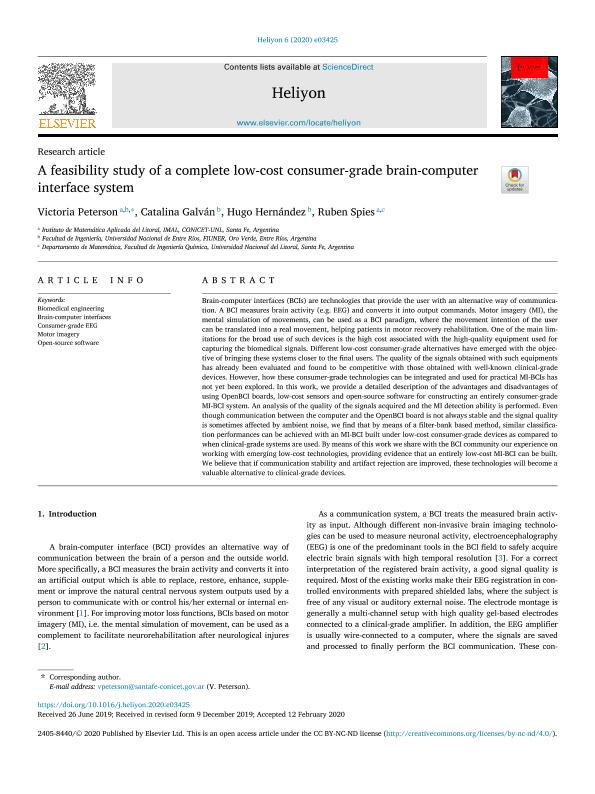Mostrar el registro sencillo del ítem
dc.contributor.author
Peterson, Victoria

dc.contributor.author
Galván, Catalina María

dc.contributor.author
Hernández, Hugo
dc.contributor.author
Spies, Ruben Daniel

dc.date.available
2020-07-06T14:44:37Z
dc.date.issued
2020-03
dc.identifier.citation
Peterson, Victoria; Galván, Catalina María; Hernández, Hugo; Spies, Ruben Daniel; A feasibility study of a complete low-cost consumer-grade brain-computer interface system; Elsevier Ltd; Heliyon; 6; 3; 3-2020; e03425-1/10
dc.identifier.issn
2405-8440
dc.identifier.uri
http://hdl.handle.net/11336/108880
dc.description.abstract
Brain-computer interfaces (BCIs) are technologies that provide the user with an alternative way of communication. A BCI measures brain activity (e.g. EEG) and converts it into output commands. Motor imagery (MI), the mental simulation of movements, can be used as a BCI paradigm, where the movement intention of the user can be translated into a real movement, helping patients in motor recovery rehabilitation. One of the main limitations for the broad use of such devices is the high cost associated with the high-quality equipment used for capturing the biomedical signals. Different low-cost consumer-grade alternatives have emerged with the objective of bringing these systems closer to the final users. The quality of the signals obtained with such equipments has already been evaluated and found to be competitive with those obtained with well-known clinical-grade devices. However, how these consumer-grade technologies can be integrated and used for practical MI-BCIs has not yet been explored. In this work, we provide a detailed description of the advantages and disadvantages of using OpenBCI boards, low-cost sensors and open-source software for constructing an entirely consumer-grade MI-BCI system. An analysis of the quality of the signals acquired and the MI detection ability is performed. Even though communication between the computer and the OpenBCI board is not always stable and the signal quality is sometimes affected by ambient noise, we find that by means of a filter-bank based method, similar classification performances can be achieved with an MI-BCI built under low-cost consumer-grade devices as compared to when clinical-grade systems are used. By means of this work we share with the BCI community our experience on working with emerging low-cost technologies, providing evidence that an entirely low-cost MI-BCI can be built. We believe that if communication stability and artifact rejection are improved, these technologies will become a valuable alternative to clinical-grade devices.
dc.format
application/pdf
dc.language.iso
eng
dc.publisher
Elsevier Ltd
dc.rights
info:eu-repo/semantics/openAccess
dc.rights.uri
https://creativecommons.org/licenses/by-nc-sa/2.5/ar/
dc.subject
BIOMEDICAL ENGINEERING
dc.subject
BRAIN-COMPUTER INTERFACES
dc.subject
CONSUMER-GRADE EEG
dc.subject
MOTOR IMAGERY
dc.subject
OPEN-SOURCE SOFTWARE
dc.subject.classification
Tecnología de Laboratorios Médicos

dc.subject.classification
Ingeniería Médica

dc.subject.classification
INGENIERÍAS Y TECNOLOGÍAS

dc.subject.classification
Otras Ciencias de la Computación e Información

dc.subject.classification
Ciencias de la Computación e Información

dc.subject.classification
CIENCIAS NATURALES Y EXACTAS

dc.title
A feasibility study of a complete low-cost consumer-grade brain-computer interface system
dc.type
info:eu-repo/semantics/article
dc.type
info:ar-repo/semantics/artículo
dc.type
info:eu-repo/semantics/publishedVersion
dc.date.updated
2020-07-01T19:54:33Z
dc.journal.volume
6
dc.journal.number
3
dc.journal.pagination
e03425-1/10
dc.journal.pais
Países Bajos

dc.description.fil
Fil: Peterson, Victoria. Universidad Nacional de Entre Ríos; Argentina
dc.description.fil
Fil: Galván, Catalina María. Universidad Nacional del Litoral; Argentina
dc.description.fil
Fil: Hernández, Hugo. Universidad Nacional de Entre Ríos; Argentina
dc.description.fil
Fil: Spies, Ruben Daniel. Consejo Nacional de Investigaciones Científicas y Técnicas. Centro Científico Tecnológico Conicet - Santa Fe. Instituto de Matemática Aplicada del Litoral. Universidad Nacional del Litoral. Instituto de Matemática Aplicada del Litoral; Argentina
dc.journal.title
Heliyon
dc.relation.alternativeid
info:eu-repo/semantics/altIdentifier/doi/http://dx.doi.org/10.1016/j.heliyon.2020.e03425
Archivos asociados
